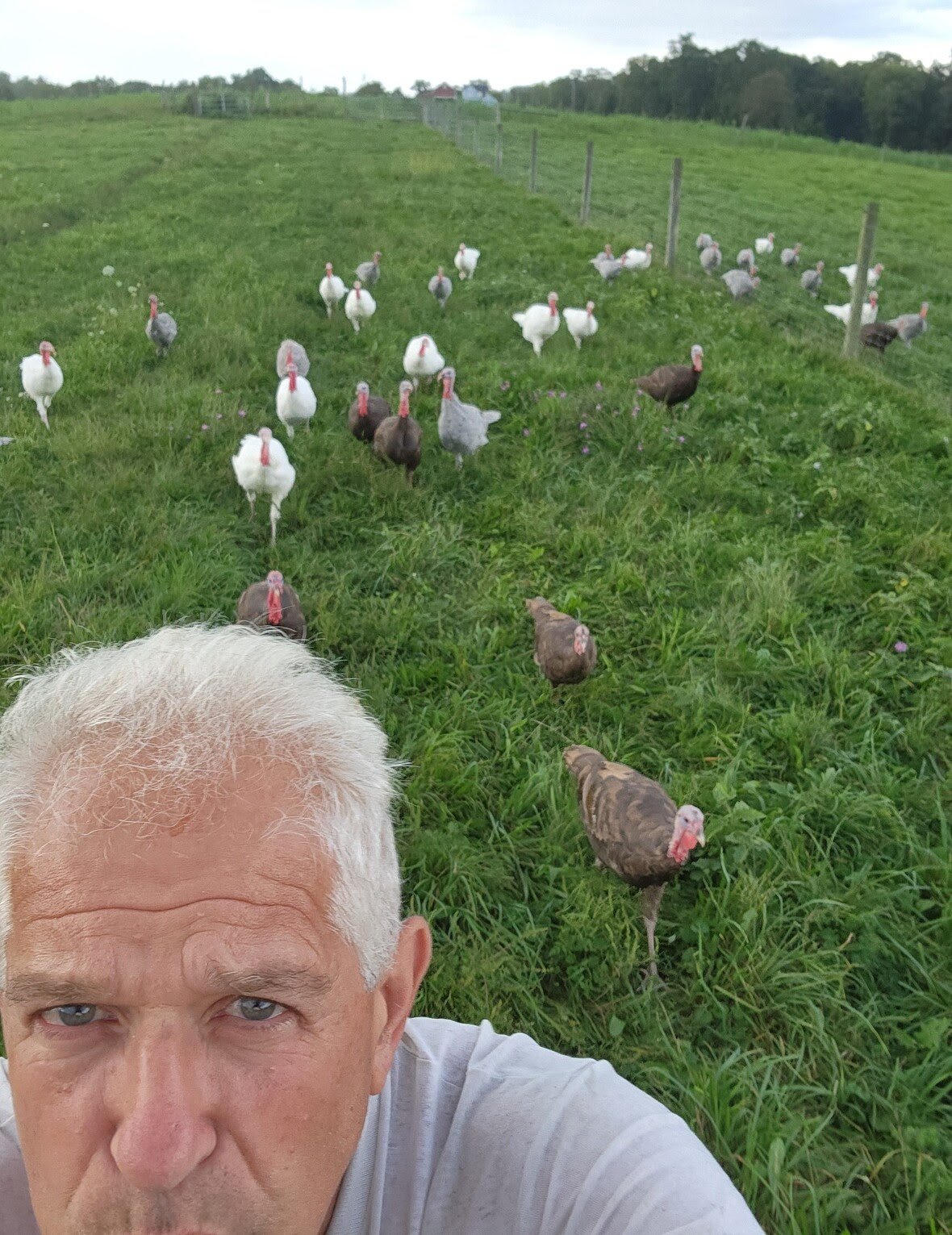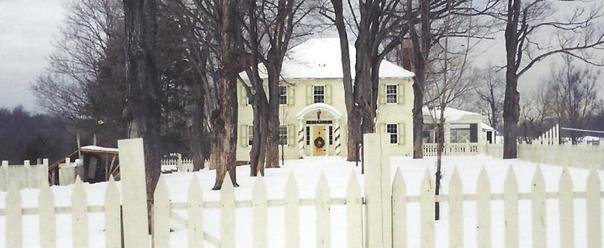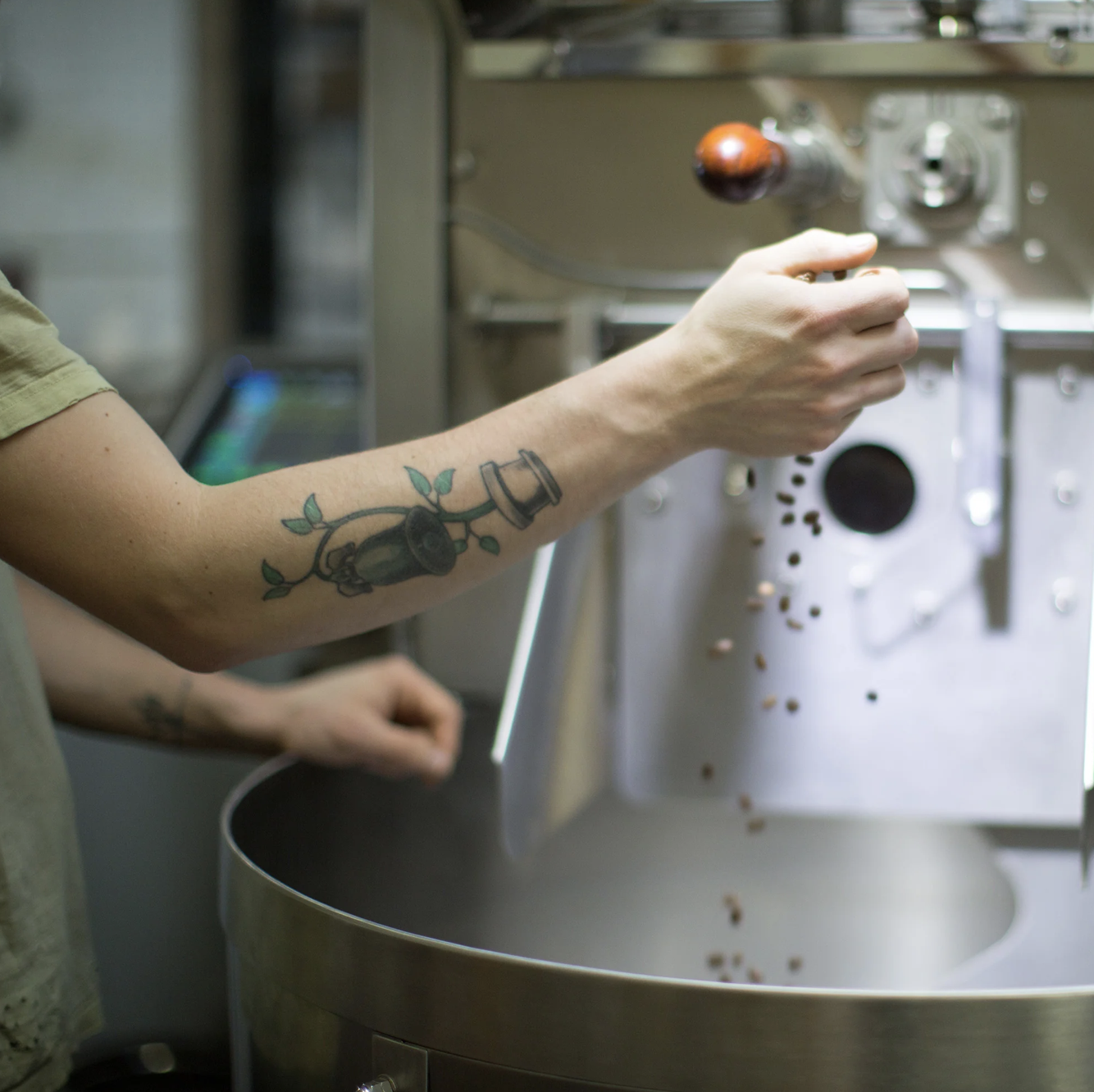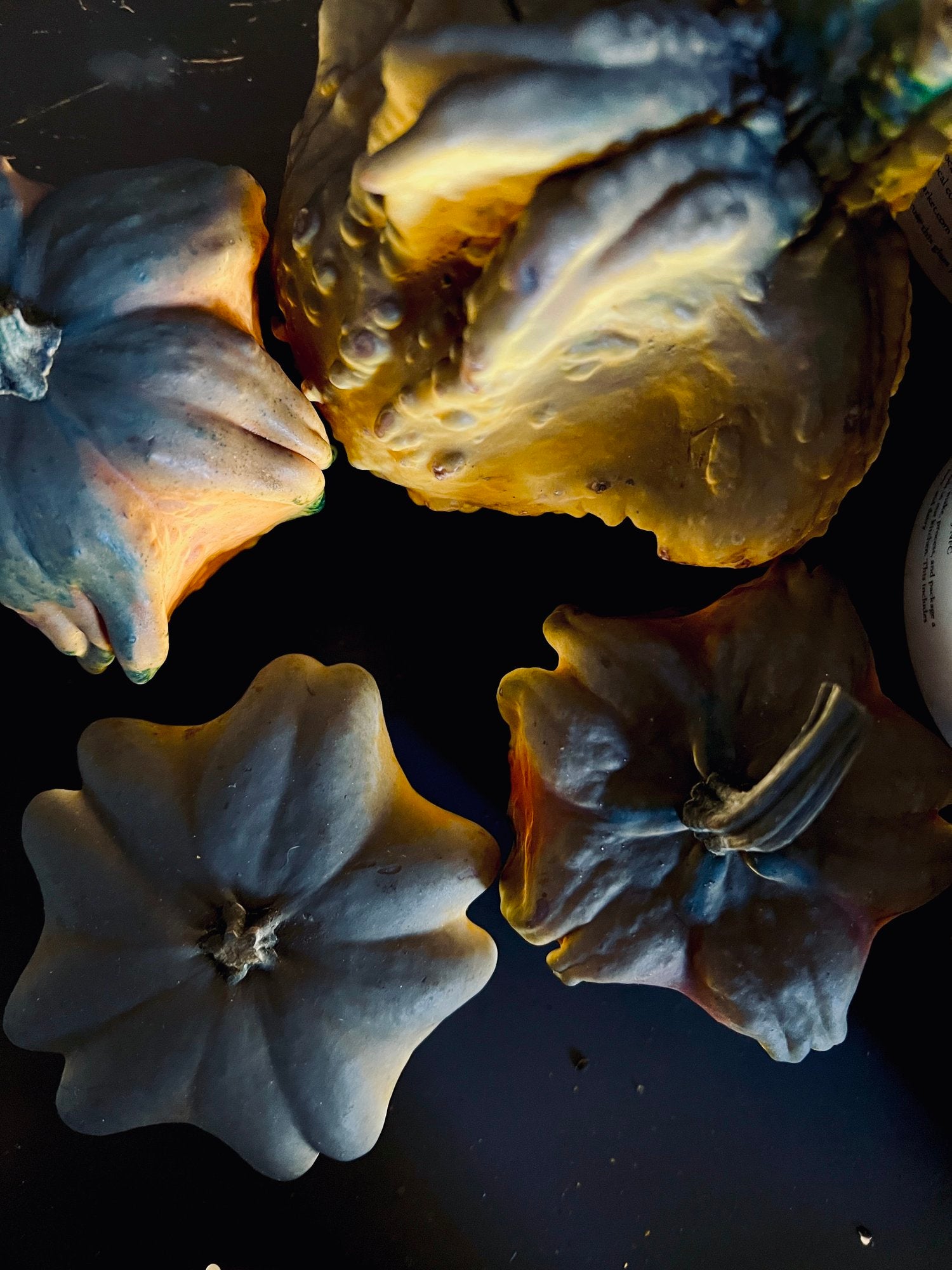Turkey Talk on Turkana Farm
There is no better time than the week before Thanksgiving to learn about Mark Scherzer, the farmer behind the heritage breed turkeys that we’re offering at Mast Market this year. Mark and his late partner Peter Davies started Turkana Farms in Germantown, New York in the early aughts, focusing on heritage breed animals as a way to protect their genetic diversity. The duo’s turkeys quickly became the star of the show and gained a loyal following in the Hudson Valley and beyond.
When Peter passed away unexpectedly in 2018, Mark took a break from raising turkeys. But he decided to get back into the turkey business this year, both for the fans and himself. “I quite enjoy them as animals,” he says. “The heritage breed birds are unlike the broad-breasted birds you buy in the supermarket. They are able to fly and we allow them to just walk through the pastures. They graze with our sheep and they're very personable birds. When you talk to them, they respond in chorus. It's quite entertaining to have them around.”
Customers seek out Mark’s heritage breed turkeys not for their personalities, but because they are simply more flavorful than the supermarket variety. “These breeds were developed in the late 19th century and early 20th century more for flavor than for the two characteristics that I think are more prevalent in modern breeds, which are fast growth and broad breasts,” he explains.
Here, Mark shares more about the advantages of heritage breed turkeys, why he loves his quiet farm life, and how he celebrates Thanksgiving.

Photography by Mark Scherzer
Mast Journal: From a cook’s perspective, what are the benefits of a heritage breed turkey?
Mark Scherzer: They're less round and more torpedo-shaped than a big Butterball turkey because they just don't have the massive breast. The breast is still a very prominent part of the anatomy, but it's not like an ever-slicing part of it because they grow slowly.
Heritage breeds live much longer than the standard breeds do. Standard breeds are often slaughtered at three and a half months. These live for six to seven months. That means they develop a layer of fat under the skin, which imparts more moistness and flavor. And because they fly and get more exercise, there's more muscle, which offers a richer flavor.
Those are probably the chief advantages, but the meat is also darker. In fact, this year I'm doing blue slates for the first time, and one of my long-time customers told me he understands that on the blue slates, even the breast meat is kind of dark, which I haven't seen yet because they're being processed today. But that would be interesting.
MJ: That is interesting. What other animals and produce do you raise and grow on the farm?
MS: We have a pretty big vegetable garden, but not commercial-scale. There are certain things I sell commercially, but it's very small quantities. The main other things I do are chickens for eggs and sheep for both wool and meat. It's like your traditional family farm. Years ago, we also had pigs and cows grazing on the land that now belong to somebody else. But we did have cows for a while for beef. I've done Guinea fowl, ducks, geese, and meat chickens. It's been highly diverse, but as one ages you want to limit things. So I'm limiting it to the things I really enjoy and relate to and I can manage on my own.
MJ: Totally. And how did you decide to buy a farm in the first place?
MS: It was my partner who introduced me to this life. He had had some experience growing up on what was the remains of a farm. And I had none, being a city and suburban boy when we first bought the place. The first time I ever touched a domesticated livestock animal was when we owned them. But I took to it. I enjoy it tremendously. It's partly that you get a lot of physical labor that you don't get in my other job.
I also always felt like I never really understood human nature as well as I did until I started raising animals. You see a lot of what's endemic to all creatures by seeing the lives of creatures who are not human. That has a tremendous attraction to me. And I just enjoy being here. I didn't actually move up full-time until my partner died and the pandemic came in quick succession, but I have now done so.
MJ: What is your other job?
MS: I'm also a lawyer.
MJ: Oh, so farming isn’t your full-time gig?
MS: Well, it is. I have two full-time gigs.
MJ: Ah, got it! So how do you balance both? What does your day-to-day routine look like?
MS: I get up in the morning, do chores, which is basically feeding and mucking out the barn and whatever. I'm at my desk by 9:30 a.m. I work a normal day, but these days, when the light doesn't last, I'm outside by 4:15 p.m. to do afternoon chores. And during the day I might be occasionally out to check on everybody and roundup stray animals. The weekends and whatever other time I can catch from my day job is spent doing the farm work. So I can't say it's all done to perfection. It's done to the maximum of my ability.
MJ: The quality of your work is probably pretty high if people keep coming back to you for turkeys and legal advice! Do you manage the farm on your own?
MS: I have a new partner who sometimes helps, but is in the city much of the time. I have friends who come by. I think part of the reason I have these friends is they love coming here and helping out with work. But there's no paid staff. On a day-to-day basis, it's me. So it's a small scale. I relate to it. It helps me process my life in general. Doing the farm work doesn't require a whole lot of intellectual engagement, so it allows your mind to focus on things in a zen kind of way. And I write a bulletin every week, which allows me to process my life in a way, too. It's usually guided by insights from the farm.
MJ: So you’re also a writer!
MS: I guess so. I'd say the turkeys have always been our signature product. And after a five year hiatus, I'm now having to build back up. There were people who would be calling each year in the interim saying, ‘Are you doing them this year? Are you doing them this year?’ But there aren't that many people.
In terms of the overall national market, heritage breed turkeys are under one percent of the turkeys sold in America. It's partly because many Thanksgiving tables have 25 people sitting around it and the birds don't get that big. The maximum weight I think I've ever gotten on one of these was 19 pounds on a big Tom, but more likely the high end is 16 or 17 pounds. And the hens are about half the size. A hen is going to be seven or eight pounds.
That's one of the reasons I guess broad-breasted birds were developed, to satisfy the millions of people who are looking at hosting a big family event. On the other hand, in this era of more atomized families, the small hens often work for more intimate thanksgivings. And I also found people who have the oven space will often prefer two small birds because they roast faster.
MJ: That’s a really good point.
MS: And if you're going to spend your oven occupied for four hours with a massive turkey, it limits your other options for a big feast. So timing birds that roast faster is an advantage that way.

Photography courtesy of Turkana Farms
MJ: Definitely. What do you like to do on Thanksgiving?
MS: Well, this is the first year in five years that I'm doing it, but before that it was basically collapse and eat one of our turkeys. It was always a very small event because after the process of distribution, you're kind of exhausted. This year, I'm having six people, including a friend who helped early in the season building new roosts for the turkeys to perch on at night. He felt like he was so invested in the process that he came up Sunday night to help me load them into a trailer yesterday to go off to for processing. And he's coming back for the feast to partake in the product.
MJ: It’s full circle! How do you cook your turkey?
MS: I use this recipe from a chef in Pittsburgh. Basically you start them out on real high heat for a half hour and then cook low and slow, like 275 or 250 degrees. If you're doing a small bird, that doesn't take that long. But the high heat followed by a low and slow seems to really seal in the flavor.
MJ: That sounds great. And where can shoppers find your turkeys, other than at Mast Market?
MS: Mostly directly from us.
MJ: How do you distribute your other goods throughout the year?
MS: Mostly just people stop in. We're a micro producer, so it's mostly local customers who are regulars and then there's the Farms2Tables app that we sell to, which is how Mast Market is carrying our turkeys.
MJ: How does the app work?
MS: This woman Patricia Wind and a colleague of hers came up with this idea some years ago, which I think addresses a lot of the issues with food distribution in a really positive way. They have listed participating farms and you have to apply to be part of it. We luckily got in on the ground floor. I think these days we would be considered too small, but when they were starting up, nothing was too small. And then they have participating purchasers who are markets or restaurants or institutions.
Each day, you list on the app what you have available and people can place orders. We use this as a way to pick-to-order. If I have 10 bunches of sorrell to sell, I list it. If somebody orders it, I can go out and pick it. As long as I accept the order by noon and print the label and have it ready, their refrigerated truck picks it up in the afternoon and brings it to their facility, where they redistribute it to a delivery truck. It's delivered to the purchaser the next morning. They're massing together lots of small producers and then delivering to larger purchasers. It's a really direct, immediate farm to table operation. They take care of all the invoicing. It is incredibly efficient.
MJ: That is so brilliant.
MS: I think it really is brilliant. It's a really excellent model. And they do it for a very reasonable commission. It's basically a trucking company, but they connect the buyer and the seller and it works very well.
MJ: It’s like a virtual farmers market.
MS: And you don't have to sit there, you don't have to have a tent and a table and all that stuff. Obviously with something like beans, where you want to pick them at the peak, you're going to pick them regardless of whether you have an order for it. But for a lot of things like greens and stuff, there's no one day that's the best to pick them. And so you can basically pick the order and you're not ending up with surplus.
MJ: That’s so smart. Where does the name Turkana Farms come from? Is it a nod to the turkeys you raise?
MS: You made the assumption that pretty much everyone makes, that Turkana Farms is aptly named because we produce turkeys. In fact, the name has nothing to do with the birds. My partner's main business was Turkana Gallery, where he sold antique kilims and other textiles from the middle east, principally from Turkiye, where he had once lived and taught. At some point, we ran another side business together, Turkana Odyssey, leading small cultural tours to Turkiye. So when we bought the farm, it just seemed a natural extension to name it Turkana Farms. There was no particular intention to raise turkeys, but since they were our biggest success it was a serendipitous choice.
More from The Journal

In conversation with Sey Coffee’s Jaime Hodgkin. Jaime shares Sey’s origin story, its guiding principles, and what he loves about working in coffee.
Read more
Our beautiful and beloved space in Mt. Kisco was destroyed by a fire last month. It is difficult to put into words what this experience is like so we’ve turned to some images we took inside the bui...
Read more